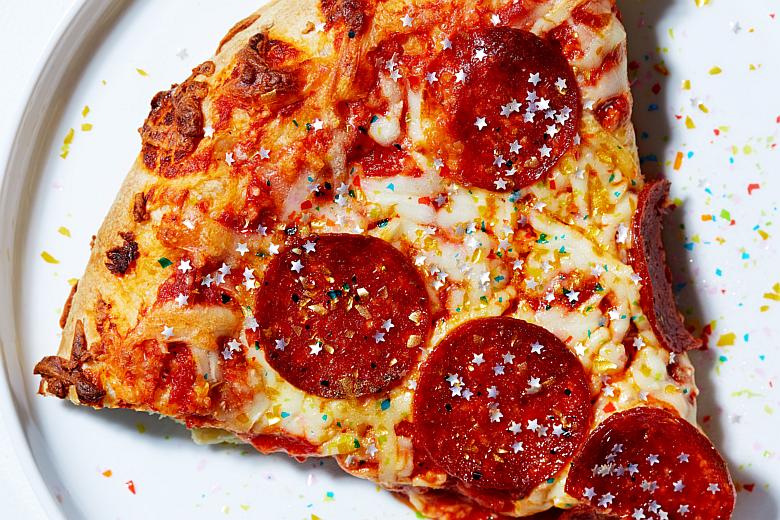Edible glitter is a thing, but should it go on everything?
Sign up now: Weekly recommendations for the best eats in town

Nothing is safe from edible glitter's reach. Edible glitter has been popping up on more and more food items lately.
PHOTO: THE WASHINGTON POST
Maura Judkis
Follow topic:
(THE WASHINGTON POST) - First things first: There is a difference between "edible" and "non-toxic" glitter. This is an important distinction you will need to remember if you want to participate in what is shaping up to be one of 2018's biggest and most controversial trends: decorating everything from cookies to pizza with a sprinkling of shiny sparkles. And no, it's not the kind you buy in the craft aisle.
Edible glitter has been popping up on more and more food items lately - a natural extension of the childlike rainbow and unicorn trends that have overtaken social media. At first, it was mostly a cake-decorating thing - wedding cakes, frosted cookies and special occasion treats.
But last year, it made the jump to coffee, adding an emphatic shimmer to latte art. It showed up in prosecco, which is already sort of sparkly to begin with. Several brewers have put it in beer.
"It gives it this really cool - it's hard to describe, but lava lamp galaxy effect in the glass," said Madeleine McCarthy, who made a glitter beer called Gold Dust Woman for Sasquatch Brewery in Portland, Oregon. "You can see all of these glitter swirls. All of it coming together in the glass is pretty magical." The beer sold out in less than a week.
But recently, glitter has made a somewhat disturbing leap into savoury foods. Glitter bagels are a thing. One London pub made glitter gravy - its sparkles an odd contrast to the brown, meaty sauce - to cheer up a basic roast. A rainbow glitter pizza from Santa Monica, California, got some buzz on Instagram. It's only a matter of time before people take it one step further. Imagine glitter ramen, glitter burgers, glitter coq au vin - this is our dystopian future.
Because one person's fun shiny accent is another person's metallic-glinted agony.
"If you get it on you, be prepared to have it on you forever," the comedian Demetri Martin once quipped about the substance. "Glitter is the herpes of craft supplies."
And it's spreading! Though she couldn't share specific figures, Jen Sagawa, the vice president of innovation for cake supply company Wilton, said that edible glitter sales have seen a "big pickup" in the last few years. The company has several edible glitter products and introduced an edible glitter spray in the last year. She thinks that Instagram has played a big part.
"You want to make your images stand out, frankly," she said. Edible glitter "makes it feel a little more special, and they can get more likes from it."
Edible glitters are made in an FDA-audited, food-safe environment, and contain ingredients that are meant to be digested. All edible glitters will be clearly labeled with the word "edible," and will also have ingredients listed on the packaging. Many edible glitters are made of sugar, cornstarch, maltodextrin and mica-based pearlescent pigments, in addition to food colouring. In January, the FDA issued an advisory warning consumers against eating glitters that are not clearly labeled "edible".
"Many decorative glitters and dusts are sold over the internet and in craft and bakery supply stores under names such as luster dust, disco dust, twinkle dust, sparkle dust, highlighter, shimmer powder, pearl dust and petal dust," said the advisory, which warned people against consuming glitter that was labeled "non-toxic."
Non-toxic glitter, the kind made for crafts, is made of plastic. It won't necessarily hurt you in a small dose. As a maker of glitter pills has found, it will, um, pass right through you. But just because something is labeled "non-toxic" doesn't mean you want it in your stomach. Elmer's glue, for example, is non-toxic, but there's a reason we don't use it on cupcakes.
Given how popular edible glitter is becoming, there's a pretty good chance it will make its way into a Starbucks Frappuccino sometime soon. And that would be a pretty good use for it, Sagawa says: "It works better if you have a little bubble or effervescence, or the consistency of a coffee or a cocoa that's going to be able to hold the glitter up."
She's seen it on yogurt and mashed potatoes and margaritas. "Once you see something is food grade and it's okay to ingest, the sky's the limit."

